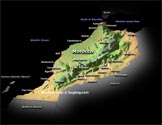Moroccan city of Meknes offers a trip back in time
 Meknes, Morocco - Surrounded by peacefully undulating green hills, the northern Moroccan city of Meknes offers travellers a trip back in time in the framework of imperial grandeur.
Meknes, Morocco - Surrounded by peacefully undulating green hills, the northern Moroccan city of Meknes offers travellers a trip back in time in the framework of imperial grandeur.
Located on the edge of the Atlas mountains, the city of nearly 1 million residents is lesser known as a tourist destination than Marrakech, Agadir or Fez.
It is, however, becoming increasingly popular among visitors to the north African kingdom where their numbers have doubled to about 8 million annually since 2001.
The massive, elaborately ornamented Bab Mansour gate opens into the 17th-century imperial city built by Moulay Ismail, the second sultan of Morocco's ruling Alawite dynasty, a legendary, ruthless and efficient ruler who has left his mark nearly all over the city.
Moroccans visiting the sultan's imposing mausoleum hope to benefit from his healing and blessing powers that still linger in its chambers and courtyards decorated with ornamental carvings, colourful tile and stucco work.
Stories about the sultan ranging from his 12,000 horses - remains of the stables and granaries are still standing - to his infamous Black Guard and his love of women are told again and again by young men who offer to show tourists around.
The daughter of France's Sun King Louis XIV, however, declined to marry a man who already had about 500 wives, the story goes.
The Alawite dynasty has retained a presence in Meknes, with centuries-old sand-coloured walls hiding, not only the remains of Moulay Ismail's palace, but also one of the residences that Morocco's current King Mohammed VI has around the country.
When the monarch was due to visit the city to open an agricultural fair in April, his arrival was the talk of the town.
Several weeks beforehand, some of the old city walls were restored, and a huge picture of Mohammed VI was displayed on the central el-Hedim square, where large crowds gathered to listen to music bands.
"We are going to celebrate for weeks," in honour of King Mohammed, a local man said. Direct criticism of the monarch, who retains vast powers, remains a taboo in Morocco, where many ordinary people still consider him an almost legendary figure.
The hustling and bustling streets of modern Meknes are a far cry from the times of Moulay Ismail, but the medina or traditional part of town, retains an atmosphere of bygone times.
Many of the countless little shops and stands lining the labyrinthine streets are now bursting with industrial goods, but it is as easy to find spices or medical herbs displayed in open sacks as self-made perfumes, soap or incense.
The medina still has a traditional caravan stop, where Amazigh (Berber) merchants leave their donkeys on the inner courtyard and rent rooms overhead when bringing their carpets, embroidered tablecloths, jewellery and other goods to market.
The medina also has entire neighbourhoods full of small workshops where craftsmen carve and paint furniture, wall and roof panels, weave thread or cloth, embroider clothes, encrust silver thread into decorative objects or bend silver into jewellery or working iron.
The star-like motifs painted on some of the panels are centuries-old, and can also be found in neighbouring Spain, where Muslims who were partly of Moroccan origin governed large areas more than 500 years ago, one of the craftsmen, Hassan Ismaili Alaoui, explained.
Craftsmen from Meknes were among the thousands of artists who participated in decorating the Hassan II mosque in Casablanca, billed as the third-largest in the world, which was built on money collected from all citizens and completed in 1993.
While some Moroccans resent having had to contribute financially to the grandiose project of the late King Hassan II, others acknowledge that the royal family has helped to promote crafts by decorating buildings in the traditional style and by wearing traditional clothing.
"Many of my clients are wealthy Moroccans," who follow the royal example, Alaoui said.
Morocco is now trying to modernize and diversify its crafts tradition, with a programme adopted in 2006 providing training for hundreds of craftsmen annually in the use of modern techniques.
Other aspects of life in the Meknes medina, however, have remained untouched by time.
Women can be seen carrying trays of unbaked loaves of bread or cookies to rooms housing communal ovens, where bakers place them on spade-like wooden instruments and push them into the blackened oven crackling with flames.
In a cave-like chamber located under the floor of the communal bath or hammam, the fire keeper crouches in front of an oven, stuffing sawdust inside to heat up the hammam where tough washerwomen are scrubbing their female clients clean and treating their hair with the rhassoul mud.
Every neighbourhood in the medina has a mosque and a Coranic school. Some have mausoleums of local saints where people gather to pray on Fridays. (dpa)